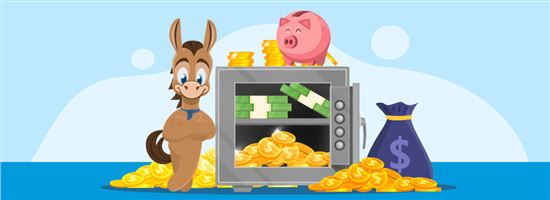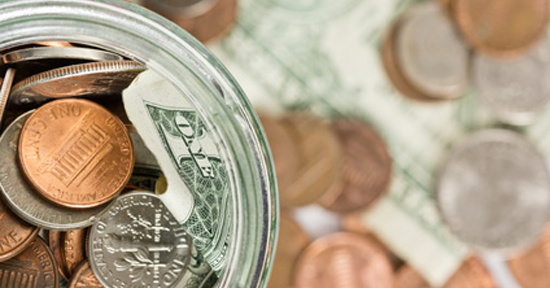11 Smart Ways to Save $1,000 a Month
Ad Disclosure: This article contains references to products from our partners. We may receive compensation if you apply or shop through links in our content. This compensation may impact how and where products appear on this site. You help support CreditDonkey by using our links.
Many Americans prefer to save money rather than spend it. Of course, saying and doing are two different things. Learn 11 smart ways to save $1,000 a month here.
 |
While the Great Recession was such a wake-up call that many do indeed save in a way they never had before 2008, people still lean on a pile of excuses for not saving as much as they would like or need to put away.
But in reality, there are many ways to do it and do it well. We came up with 11 areas you can cut back or be wiser with your money so that you can sock away $1,000 per month, based on our estimates.
- 1. Create a penalty jar
- 2. Stop loaning money to Uncle Sam
- 3. Conquer the 5% challenge
- 4. Set a strategy for the supermarket
- 5. Improvise for income
- 6. Be fanatical about fees
- 7. Review your technology
- 8. Rethink your recurring expenses
- 9. Forget about brand names
- 10. Be smarter about using credit cards
- 11. Automate your finances
- 12. Repay student loans fast
- 13. Set a budget
- 14. Stash your cash in a CD
1. Create a penalty jar
 |
Maybe you have trouble giving up the goodies - the little luxuries that add up.
Give yourself a nudge by putting a penalty tax on your excess splurges. Take certain categories - like your booze purchases, Starbucks pastries, manicures/pedicures, and cigarettes - and match each receipt with a savings deposit. For example, when you spend $20 for a mani-pedi, put that same amount into your secret stash until you build a tidy sum worthy of a trip to the bank.
If you can't afford to save the matching amount, that means you can't afford the treat. Assuming you're a big spender and adopt this method, you could become a big saver, as much as $200 or more a month.
CIT Bank Platinum Savings - $300 Bonus
- Qualify for a $300 cash bonus with a minimum deposit of $50,000
- This limited-time offer to qualify for a $225 cash bonus with a minimum deposit of $25,000 or a $300 bonus with a minimum deposit of $50,000 is available to New and Existing Customers who meet the Platinum Savings promotion criteria. The Promotion begins on September 23, 2025, and can end at any time without notice.
2. Stop loaning money to Uncle Sam
"Your income tax refund is really an interest-free loan to IRS," says Jordan Niefeld, CPA at Gerstle, Rosen & Goldenberg, PA. "In reality, it's your money you could have during the year to pay bills, reduce credit card balances and invest for your retirement. If your refund is $3,000, you could have about $250 more each month in take-home pay by adjusting your federal withholding."
If you get a sizeable refund at tax time, remember it's not a windfall, but instead a sign you need to review your W4. Determine whether you've selected the right number of withholding allowances. If you're getting a refund in the neighborhood of $2,000, figure that's about $167 a month you could instead put aside in your savings account to earn interest before tax time rolls around (around $15 per year).
3. Conquer the 5% challenge
There's no getting around taking a hard look at all your expenses, especially the discretionary ones. It's hard to go cold turkey and cut out entire categories of spending, but you can come up with a compromise.
Can you stomach spending 5% less? If you're spending $400 a month, between lunches outside of the office, happy hour with co-workers, and restaurant and bar hopping with friends, you sure can. By spending just $20 less a month, over a year you'll save $240.
4. Set a strategy for the supermarket
One of the biggest budget busters can be the supermarket. Even a small family can easily rack up weekly grocery bills of $150-$200. If you can tame the supermarket lion, not only will you spend less time standing in line, you'll have a bit more in your pocket too.
The only way to pull it off is with a plan. Always shop with a list and stick to it. Don't shop while hungry, or you'll buy all sorts of stuff you don't need. Take a hard look at coupons and fliers so you can get the best deals.
And use a credit card that gives back money for your grocery shopping (some go as high as 6%– that's a better return than what you'll get for a typical savings account). Shop smarter and you can shave off at least $50 each week in out-of-pocket expenses.
You can double up on savings with cashback apps like Ibotta. You earn rewards and coupons for everyday shopping.
5. Improvise for income
"A side hustle is one of the best ways to increase your savings fast without sacrificing your lifestyle," says Sophia Bera, a Certified Financial Planner and founder of Gen Y Planning.
Take advantage of opportunities that are right in front of you. Say you're a soccer mom or dad and you're always surrounded by other thirsty parents whose throats dry from cheering. Next time, take a cooler full of bottled water that you got a great price on and sell it. Maybe you're handy at fixing things around your house.
Don't be shy about letting people know, especially seniors and single mothers who may need assistance. Even a couple of service calls a month can mean more money for you to squirrel away. Consider too, whether there are opportunities for you to make money grocery shopping for neighbors and taking seniors to doctor's appointments, or taking other people's kids to their after-school activities. If you squeeze in just six free hours a week at $12 per hour, you can earn an extra $3,744 a year for your piggy bank.
6. Be fanatical about fees
If you look at all the fees in your life and find ways to eliminate them one by one - well, you wouldn't feel like you hit the lottery, but you could have huge monthly savings. This includes the $2-$3 you pay when you use an ATM other than your bank's and the late fees on credit cards that can be $20-$30 and more a month (and worse still if late payments cause your interest rate to rise).
You may be paying a monthly fee for a checking account when other banks would be willing to give you one for free. Go through your financial accounts line by line, and you may be surprised by some of the fees you're paying. See what you can eliminate, consider switching service providers, and set up automatic payments if you are a chronic late payer. We bet you can be rewarded from this work with at least $15 per month.
7. Review your technology
In this very wired world, you have all manner of technology at your fingertips. Convenience isn't always cheap. Scrutinize your tech-related expenses. Are you getting the best deal on your cell phone package? Look around to see if there are new deals that make it worth switching.
The same goes for your Internet service provider and cable television. How much television do you actually watch, and what channels are truly favorites? "Reassessing your cable or phone package could result in huge savings!" says Bera. "Ditch the cable for Hulu Plus and Netflix instead." At the very least, see where you can bundle services to get the best deal. It could also be time to get rid of your landline at home. A conservative estimate is a $50-per-month savings.
8. Rethink your recurring expenses
Do a reality check. What do you have and what do you really use? If you're paying $75-$100 or more a month for a gym membership and you haven't seen the inside of the gym in months, admit that you're no gym rat and put that money toward savings instead.
Same goes for subscriptions. If you're not reading those magazines, cancel them. Review your car, life, and home or renter's insurance polices. Has anything in your life changed so that you should be paying less? Consider raising deductibles and ask about any "no claim discounts."
Shop around for your insurance policies, and you may be able to save a few hundred dollars monthly. Assuming at least one of these areas is one you can trim, you could save $150 a month.
9. Forget about brand names
Being a label lover is a luxury. You can easily save 50-60% when buying generic at the grocery store. The strategy is smart when shopping elsewhere too. Every month there is a present you need to buy for a birthday, baby shower, or wedding, or there is an event that requires a new outfit. Whatever the reason that has you on the hunt for stuff, forgo top brands, unless you're getting them at a deep discount from the outlets or discount retailers. At the very least, you should be able to save around $60 a month.
10. Be smarter about using credit cards
When you use certain credit cards wisely (that means paying off your balance every month), you can save up real cash. Just like the grocery cards we mentioned above, issuers will reward you for your spending with cash back or rewards.
If you don't get distracted and spend money just to get a deal, you can earn funds on money you would spend anyway. For instance, some popular cashback programs will give you as much as 5% back on up to $1,500 each quarter (on certain purchases that change every three months). So at a minimum, that's another $25 in your wallet each month.
By a similar token, Bera notes that frequent travelers like her can save lots of money on expensive vacations with a travel rewards card: "We've saved thousands of dollars in airfare from combining our points to redeem for travel rewards. Last year we had enough points for two roundtrip tickets to Costa Rica and this year our points paid for two roundtrip tickets to Peru!"
Related: Best Credit Cards
CreditDonkey lives and breathes finding deals and pocketing savings. If you are on the savvier side of managing your finances, you may have already taken some of these steps, and your ability to realize the full estimated $1,000 may not be reached. But many of these are worth revisiting periodically to see if unnecessary expenses and hidden costs are creeping into your life, crimping your ability to save - and adding to your excuses.
CIT Bank Platinum Savings - $225 Bonus
- Qualify for a $225 cash bonus with a minimum deposit of $25,000
- This limited-time offer to qualify for a $225 cash bonus with a minimum deposit of $25,000 or a $300 bonus with a minimum deposit of $50,000 is available to New and Existing Customers who meet the Platinum Savings promotion criteria. The Promotion begins on September 23, 2025, and can end at any time without notice.
CIT Bank Platinum Savings - 3.85% APY
- 3.85% APY with a balance of $5,000 or more
- 0.25% APY with a balance of less than $5,000
- $100 minimum opening deposit
- No monthly maintenance fee
- Member FDIC
UFB Portfolio Savings - Earn up to 3.51% APY
- Earn up to 3.51% APY.*
- No monthly maintenance fees.
- No minimum deposit required to open an account.
- Access your funds 24/7 with easy-to-use digital banking tools.
- Enjoy peace of mind with FDIC insurance up to the maximum allowance limit – Certificate #35546.
11. Automate your finances
If you have trouble saving money, consider starting small with micro-investing apps. These apps "round up" everyday purchases and help you invest, even if it's a few dollars. Apps like Qapital and Acorns are just a few savings/investing apps that do this for you.
So, if your Friday takeout costs $24.34, then the app will invest that $0.66 loose change into a portfolio for you. It's completely hands-off and requires no thinking or work on your end.
And over time, these little micro-savings save up to a hard-earned summer vacay or down payment for a new car. These apps let you set goals so you can make a fund for emergencies, college, retirement and more.
If you're interested in having your savings tucked away on autopilot, take a look at this list of automatic savings apps.
12. Repay student loans fast
If you can afford it, getting rid of your student loan debt early can improve your savings month to month. You'll have more to invest (the average annual S&P returns are around 10% versus student debt debt 4% - 7%).
Pay a little extra every month and you could save so much in interest charges over the life of your loan. Be sure to start with the most expensive loan with the highest interest rates to save you the most money in the long run. Also consider saving on expenses by living with your parents. It's a sacrifice but you'll make huge headway on your student debt.
Also, research repayment plan options to make your loans more manageable.
13. Set a budget
The fastest (and easiest) way to lose track of your money is not following a budget. Create a spending plan to prioritize your financial goals and everyday necessities.
Try using the 50/30/20 budget for smart money management. This means you allocate 50% of your income to necessities, 30% to wants and 20% to savings. If you discover that one of your allocations exceed this formula then it's time to make some adjustments. This budget calculator will help you visualize your monthly cash flow.
As you set up a budget, consider storing your money in a high yield savings account.
14. Stash your cash in a CD
Another good way to save money? Get rewarded for not touching your money.
If you don't mind mind tying up your money for a set period of time, CD rates can net you pretty decent returns.
Certificates of Deposits require you to deposit a fixed amount of money for a fixed amount of time in exchange for a set interest rate. That interest will be honored for the duration of that term. If you withdraw your money early, you'll be subject to penalties and fees.
If you have more money to invest, you can earn more with a strategy called CD laddering. Basically, you split up your investments into different CDs with different rates and terms. That way you'll consistently get the best APY available and easier access to your money.
Sheryl Nance-Nash is a journalist at CreditDonkey, a personal finance comparison and reviews website. Write to Sheryl Nance-Nash at sheryl@creditdonkey.com. Follow us on Twitter and Facebook for our latest posts.
Note: This website is made possible through financial relationships with some of the products and services mentioned on this site. We may receive compensation if you shop through links in our content. You do not have to use our links, but you help support CreditDonkey if you do.
Read Next:


